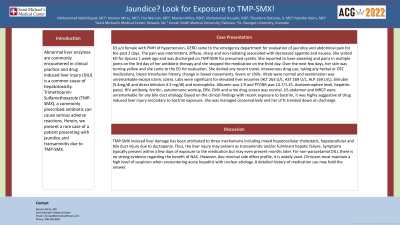Back


Poster Session B - Monday Morning
Category: Liver
B0563 - Jaundice? Look for Exposure to TMP-SMX!
Monday, October 24, 2022
10:00 AM – 12:00 PM ET
Location: Crown Ballroom

Has Audio

Noreen Mirza, MD
Saint Michael's Medical Center, New York Medical College
Newark, NJ
Presenting Author(s)
Mohammad Nabil Rayad, MD1, Noreen Mirza, MD1, Fnu Marium, MD2, Mariam Mirza, BSN3, Muhammad Hussain, MD1, Theodore Dacosta, MD, DO4, Yatinder Bains, MD1
1Saint Michael's Medical Center, New York Medical College, Newark, NJ; 2Jinnah Sindh Medical University, Newark, NJ; 3St. Georges University, Newark, NJ; 4Saint Michael's Medical Center, Newark, NJ
Introduction: Abnormal liver enzymes are commonly encountered in clinical practice and drug induced liver injury (DILI) is a common cause of hepatotoxicity. Trimethoprim-Sulfamethoxazole (TMP-SMX), a commonly prescribed antibiotic can cause serious adverse reactions. Herein, we present a rare case of a patient presenting with jaundice and transaminitis due to TMP-SMX.
Case Description/Methods: 83 y/o female with PMH of hypertension, GERD came to the emergency department for evaluation of jaundice and abdominal pain for the past 2 days. The pain was intermittent, diffuse, sharp and non-radiating associated with decreased appetite and nausea. She visited ED for dysuria 1 week ago and was discharged on TMP-SMX for presumed cystitis. She reported to have sweating and pains in multiple joints on the 3rd day of her antibiotic therapy and she stopped the medication on the third day. Over the next few days, her skin was turning yellow and she came to the ED for evaluation. She denied any recent travel, intravenous drug use, taking any herbal or OTC medications, blood transfusion history, change in bowel movements, fevers or chills. Vitals were normal and examination was unremarkable except icteric sclera. Labs were significant for elevated liver enzymes (ALT 263 U/L, AST 169 U/L, ALP 169 U/L), bilirubin (5.4mg/dl and direct bilirubin 4.3 mg/dl) and eosinophilia. Albumin was 2.9 and PT/INR was 14.7/1.25. Acetaminophen level, hepatitis panel, HIV antibody, ferritin, autoimmune workup, EBV, CMV and urine drug screen was normal. US abdomen and MRCP were unremarkable for any bile duct etiology. Based on the clinical findings with recent exposure to bactrim, it was highly suggestive of drug induced liver injury secondary to bactrim exposure. She was managed conservatively and her LFTs trended down on discharge.
Discussion: TMP-SMX induced liver damage has been attributed to three mechanisms including mixed hepatocellular cholestatic, hepatocellular and bile duct injury due to ductopenia. Thus, the liver injury may present as transaminitis and/or fulminant hepatic failure. Symptoms typically present within a few days of exposure to the medication but may even present months later. For non-paracetamol DILI, there is no strong evidence regarding the benefit of NAC. However, due minimal side effect profile, it is widely used. Clinicians must maintain a high level of suspicion when encountering acute hepatitis with unclear etiology. A detailed history of medication use may hold the answer.
Disclosures:
Mohammad Nabil Rayad, MD1, Noreen Mirza, MD1, Fnu Marium, MD2, Mariam Mirza, BSN3, Muhammad Hussain, MD1, Theodore Dacosta, MD, DO4, Yatinder Bains, MD1. B0563 - Jaundice? Look for Exposure to TMP-SMX!, ACG 2022 Annual Scientific Meeting Abstracts. Charlotte, NC: American College of Gastroenterology.
1Saint Michael's Medical Center, New York Medical College, Newark, NJ; 2Jinnah Sindh Medical University, Newark, NJ; 3St. Georges University, Newark, NJ; 4Saint Michael's Medical Center, Newark, NJ
Introduction: Abnormal liver enzymes are commonly encountered in clinical practice and drug induced liver injury (DILI) is a common cause of hepatotoxicity. Trimethoprim-Sulfamethoxazole (TMP-SMX), a commonly prescribed antibiotic can cause serious adverse reactions. Herein, we present a rare case of a patient presenting with jaundice and transaminitis due to TMP-SMX.
Case Description/Methods: 83 y/o female with PMH of hypertension, GERD came to the emergency department for evaluation of jaundice and abdominal pain for the past 2 days. The pain was intermittent, diffuse, sharp and non-radiating associated with decreased appetite and nausea. She visited ED for dysuria 1 week ago and was discharged on TMP-SMX for presumed cystitis. She reported to have sweating and pains in multiple joints on the 3rd day of her antibiotic therapy and she stopped the medication on the third day. Over the next few days, her skin was turning yellow and she came to the ED for evaluation. She denied any recent travel, intravenous drug use, taking any herbal or OTC medications, blood transfusion history, change in bowel movements, fevers or chills. Vitals were normal and examination was unremarkable except icteric sclera. Labs were significant for elevated liver enzymes (ALT 263 U/L, AST 169 U/L, ALP 169 U/L), bilirubin (5.4mg/dl and direct bilirubin 4.3 mg/dl) and eosinophilia. Albumin was 2.9 and PT/INR was 14.7/1.25. Acetaminophen level, hepatitis panel, HIV antibody, ferritin, autoimmune workup, EBV, CMV and urine drug screen was normal. US abdomen and MRCP were unremarkable for any bile duct etiology. Based on the clinical findings with recent exposure to bactrim, it was highly suggestive of drug induced liver injury secondary to bactrim exposure. She was managed conservatively and her LFTs trended down on discharge.
Discussion: TMP-SMX induced liver damage has been attributed to three mechanisms including mixed hepatocellular cholestatic, hepatocellular and bile duct injury due to ductopenia. Thus, the liver injury may present as transaminitis and/or fulminant hepatic failure. Symptoms typically present within a few days of exposure to the medication but may even present months later. For non-paracetamol DILI, there is no strong evidence regarding the benefit of NAC. However, due minimal side effect profile, it is widely used. Clinicians must maintain a high level of suspicion when encountering acute hepatitis with unclear etiology. A detailed history of medication use may hold the answer.
Disclosures:
Mohammad Nabil Rayad indicated no relevant financial relationships.
Noreen Mirza indicated no relevant financial relationships.
Fnu Marium indicated no relevant financial relationships.
Mariam Mirza indicated no relevant financial relationships.
Muhammad Hussain indicated no relevant financial relationships.
Theodore Dacosta indicated no relevant financial relationships.
Yatinder Bains indicated no relevant financial relationships.
Mohammad Nabil Rayad, MD1, Noreen Mirza, MD1, Fnu Marium, MD2, Mariam Mirza, BSN3, Muhammad Hussain, MD1, Theodore Dacosta, MD, DO4, Yatinder Bains, MD1. B0563 - Jaundice? Look for Exposure to TMP-SMX!, ACG 2022 Annual Scientific Meeting Abstracts. Charlotte, NC: American College of Gastroenterology.
